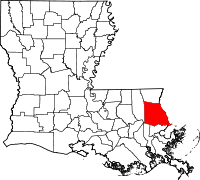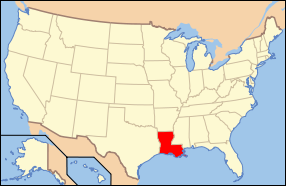St. Tammany Parish, Louisiana
| Saint Tammany Parish, Louisiana | |
| Map | |
 Location in the state of Louisiana |
|
 Louisiana's location in the U.S. |
|
| Statistics | |
| Founded | 1810 |
|---|---|
| Seat | Covington |
| Largest city | Slidell |
| Area - Total - Land - Water |
854 sq mi (2,212 km²) 717 sq mi (1,857 km²) 270 sq mi (699 km²), 24.01% |
| Population - (2000) - Density |
191,268 267/sq mi (103/km²) |
| Time zone | Central: UTC-6/-5 |
| Website: www.stpgov.org | |
| Named for: Indian Chief Tamanend | |
| County flag | |
St. Tammany Parish (French: Paroisse de Saint-Tammany) is a parish located in the U.S. state of Louisiana, in the New Orleans–Metairie–Kenner Metropolitan Statistical Area. The parish seat is Covington. As of 2000, the population was 191,268. In 2004, the population was estimated to have grown to 212,000, and after the landfall of Hurricane Katrina the following year, the population was estimated by St. Tammany Planners to be about 264,000. Most new residents are thought to have come from St. Bernard Parish. If correct, these figures make St. Tammany Parish the fastest-growing parish in the state, overtaking Livingston and Ascension parishes.
The Moon Handbooks New Orleans: Including Cajun Country and the River Road, published in 2007, stated that people wanting to live in close proximity to New Orleans without living in New Orleans will likely cause the population of St. Tammany Parish to increase. [1]
Contents |
History
Pre-history
In 1699, Pierre Le Moyne d'Iberville, a French explorer, became the first European to visit the area of present-day St. Tammany Parish. While exploring lakes Pontchartrain and Maurepas, Iberville wrote in his journal, "The place where I am is one of the prettiest I have seen, fine level ground bare of canes. The land north of the lakes is a country of pine trees mixed with hard woods. The soil is sandy and many tracks of buffalo and deer can be seen."
St. Tammany was originally inhabited by numerous Indian peoples, including the Colapissas, Bayou Goulas, Chickasaw, Biloxi, Choctaw, and Pensacola nations (although, Frederick S. Ellis, in his book St. Tammany Parish: L’autre Côté du Lac, claims that the regionally prominent Choctaw tribe did not arrive to the area until after it had begun to be settled by Europeans).
West Florida
After the founding and development of New Orleans, French settlers began to enter the region. Their primary industry was the production of pitch, tar, turpentine and resin from the forests.
After the French were defeated in the French and Indian War, St. Tammany (like the surrounding regions of the Florida Parishes) became part of English West Florida. Then, after Britain was defeated in the American Revolutionary War, West Florida was governed by the Spanish. During the West Florida period, St. Tammany, like the rest of West Florida, attracted British loyalists who wanted to escape persecution in the 13 colonies. The West Florida period ended with the West Florida Revolt, which preceded West Florida's annexation by the United States.
Creation and naming of the parish
In 1810, President James Madison claimed West Florida as part of Louisiana and sent William C.C. Claiborne to claim the territory. Claiborne established the boundaries of the Florida Parishes. He created St. Tammany Parish and named it after the Delaware Indian Chief Tamanend (c.1628-1698), who made peace with William Penn and was generally renowned for his goodness.[1] Among the nine Louisiana parishes (counties) named for "saints" (see "List of parishes of Louisiana"), Saint Tammany is the only one whose eponym is not a saint as recognized by the Roman Catholic Church, the ecclesiastical parishes of which formed the basis for civil parishes prior to statehood. In fact, Tamanend is not known to have been a Christian, and was certainly not a Roman Catholic. However, he became popularly revered as an "American patron saint" in the post-Revolutionary period (long after his death).
19th century
Before 1834, there were only two towns in St. Tammany: Covington, a retreat with summer homes and hotels; and Madisonville, a shipbuilding and sawmill town. The area south to Lake Ponchartrain all the way to the Pearl River were known as the Covington Lowlands, this includes Mandeville, Abita Springs, Lacombe, Slidell, and Pearl River. Mandeville was developed that year as a health resort for wealthy New Orleanians, because they believed that Ozone was emitted from the numerous trees in the area and became an immediate success, spurring the development of another resort community, Abita Springs. A railroad connected the towns to Mandeville and further to New Orleans, allowing for a burgeoning of growth in Abita Springs, where underground spring waters furnished supposedly healthful baths for public use.
20th century
After the construction of the Lake Pontchartrain Causeway, Interstate 12 and Interstate 10, people began to relocate to St. Tammany in large numbers.
While the economy of the Greater New Orleans Metro area began to have several major problems,(very high taxes on the middle class) the middle and upper classes began to move further and further from New Orleans, eventually moving across Lake Pontchartrain to the then mostly rural St. Tammany. Population and economic growth accelerated after 1956, when the first span of the Lake Ponchartrain Causeway bridge was completed. The population exceeded 200,000 in the wake of Hurricane Katrina's landfall in 2005.
Geography
The parish has a total area of 1,124 square miles (2,911 km²), of which, 854 square miles (2,212 km²) of it is land and 270 square miles (699 km²) of it (24.01%) is water.
Major highways
|
|
Adjacent parishes and natural features
- Washington Parish (north)
- Pearl River County, Mississippi (northeast)
- Hancock County, Mississippi (east)
- Orleans Parish (south and southeast 24.5 miles across the Lake Ponchartrain Causeway Bridge)
- Lake Pontchartrain (south)
- Jefferson Parish (southwest)
- Tangipahoa Parish (west)
National protected areas
- Big Branch National Wildlife Refuge
- Bogue Chitto National Wildlife Refuge (part)
Demographics
| Historical populations | |||
|---|---|---|---|
| Census | Pop. | %± | |
| 1900 | 13,335 |
|
|
| 1910 | 18,917 | 41.9% | |
| 1920 | 20,645 | 9.1% | |
| 1930 | 20,929 | 1.4% | |
| 1940 | 23,624 | 12.9% | |
| 1950 | 26,988 | 14.2% | |
| 1960 | 38,643 | 43.2% | |
| 1970 | 68,585 | 77.5% | |
| 1980 | 110,869 | 61.7% | |
| 1990 | 144,508 | 30.3% | |
| 2000 | 191,268 | 32.4% | |
| Est. 2006 | 230,605 | [2] | 20.6% |
| St. Tammany Parish Census Data[3] | |||
As of the census[4] of 2000, there were 191,268 people, 69,253 households, and 52,701 families residing in the parish. The population density was 224 people per square mile (86/km²). There were 75,398 housing units at an average density of 88 per square mile (34/km²). The racial makeup of the parish was 87.03% White, 9.90% Black or African American, 0.43% Native American, 0.74% Asian, 0.03% Pacific Islander, 0.61% from other races, and 1.26% from two or more races. 2.48% of the population were Hispanic or Latino of any race.
There were 69,253 households out of which 39.30% had children under the age of 18 living with them, 61.40% were married couples living together, 11.00% had a female householder with no husband present, and 23.90% were non-families. 19.70% of all households were made up of individuals and 6.70% had someone living alone who was 65 years of age or older. The average household size was 2.73 and the average family size was 3.15.
In the parish the population was spread out with 28.40% under the age of 18, 7.30% from 18 to 24, 29.90% from 25 to 44, 24.30% from 45 to 64, and 10.00% who were 65 years of age or older. The median age was 36 years. For every 100 females there were 96.10 males. For every 100 females age 18 and over, there were 92.40 males.
The median income for a household in the parish was $47,883, and the median income for a family was $55,346. Males had a median income of $41,876 versus $25,996 for females. The per capita income for the parish was $22,514. About 7.60% of families and 9.70% of the population were below the poverty line, including 11.80% of those under age 18 and 10.10% of those age 65 or over.
2008 and 2004 Election Results
St. Tammany Parish has been heavily Republican in recent years and 2008 was no exception. John McCain received 76% of the vote there and 83,078 votes. Democrat Barack Obama came in far behind receiving 23% of the vote and 24,596 votes. In the Senate election, although Democrat Mary Landrieu won the election, she lost St. Tammany Parish. Republican John Kennedy won 61% of the vote and 65,150 votes. Landrieu won 36% of the vote and 39,429 votes. In 2004, Republican George W. Bush won 75% of the vote and 75,139 votes. Democrat John F. Kerry won 24% of the vote and 24,662 votes. The reason that McCain won St. Tammany Parish by a larger margin than Bush is most likely due to the fast growth in St. Tammany Parish and the movement of the population of Republican St. Bernard Parish to St. Tammany Parish.[5]
Municipalities
Cities
- Covington
- Mandeville
- Slidell
Towns
- Abita Springs
- Madisonville
- Pearl River
Villages
- Folsom
- Sun
Census-designated places
- Eden Isle
- Lacombe
Unincorporated places
- Alton
- Amos
- Audubon
- Big Branch
- Blond
- Bonfouca
- Bush
- Chinchuba
- Crawford Landing
- Dave
- Davis Landing
- Florenville
- Goodbee
- Haaswood
- Houltonville
- Hickory
- Lewisburg
- Maude
- McClane City
- Morgan Bluff
- North Slidell
- Oaklawn
- St. Benedict
- St. Joe
- St. Tammany
- St. Tammany Corner
- Talisheek
- Waldheim
- White Kitchen
Education
St. Tammany Parish Schools operates the public schools in the parish.
References
- ↑ Blake Ponchartrain: New Orleans Know-It-All, 2 May 2006, bestofneworleans.com, Accessed 14 November 2008.
- ↑ United States Census Bureau. "St. Tammany Parish Quickfacts". Retrieved on 2007-06-12.
- ↑ United States Census Bureau. "Louisiana Population of Counties by Decennial Census: 1900 to 1990". Retrieved on 2007-06-12.
- ↑ "American FactFinder". United States Census Bureau. Retrieved on 2008-01-31.
- ↑ http://www.uselectionatlas.org/RESULTS/
External links
- St. Tammany Parish government's website
- St. Tammany school board's website
- Explore the History and Culture of Southeastern Louisiana, a National Park Service Discover Our Shared Heritage Travel Itinerary
|
|||||||||||||||||||||||
|
